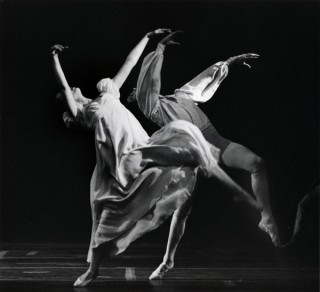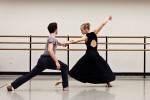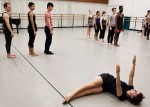Title
Subhead

In this year’s edition of Juilliard Dances Repertory, students will reprise José Limón’s Waldstein Sonata, which was completed by former faculty member (and alum) Daniel Lewis and premiered by the Juilliard Dance Ensemble at Juilliard in April 1975 (pictured).
(Photo by Lois Greenfield)Each spring, the Dance Division mounts three repertory works; each of this year’s (March 28-April 1) has connections with the Juilliard dance community. Here, the division’s associate director, Risa Steinberg, writes about José Limón’s Waldstein Sonata, based on the Beethoven piano sonata commonly referred to as “the Waldstein.” Steinberg, who is directing Janet Pilla’s staging of the work, studied with Limón at Juilliard and joined his eponymous company in the early 1970s, a few years before he started choreographing Waldstein, which was premiered at Juilliard in 1975. Alumnus Ohad Naharin’s Secus is also on the program, and Lawrence Rhodes, artistic director of the division, writes about his early encounters with the choreographer. Rounding out the repertory is Gnawa, by Spanish choreographer Nacho Duato. Ballet faculty member Francisco Martinez, who danced in the world premiere of a forerunner of the piece, recalls the experience of working with Duato.
Body
The Waldstein Sonata
If you look at the score of Beethoven’s “Waldstein” Sonata (Piano Sonata No. 21 in C Major, Op. 53), you are immediately brought into the life that I imagine José Limón heard, saw in his mind, and then began to create for his dance company in 1971.
This work for eight dancers—four women and four men—sweeps across the stage, feeling every note as if each step was having some relationship in making its sound. It is not uncommon to have the heartbeat and drama of Limón’s work be driven by the pulse and density of the sound, but, for me, this work is sheer physical music.
When I entered the Limón Company, José was just putting this piece aside and it was unclear whether he anticipated finishing it later or not. His death in 1972 did not allow that to happen. In 1975, Daniel Lewis, a Juilliard alum who was on the faculty at that time, was Limón’s protégé. With the support of Martha Hill, the founding director of the Dance Division, and then-president of Juilliard Peter Mennin, Lewis decided to both complete the last movement and get it to where it belonged—the stage. Its premiere performance, by the Juilliard Dance Ensemble, was in April 1975.
Once the choice was made that this piece was going to be brought back to our stage after so many years, it became clear to me that for one to truly understand this work, studying the score was a necessity. And so Janet Pilla, the reconstructor, and I dove into each page. There it was in black and white, every swell, every choice to syncopate a step and each suspension, right there before our eyes. How thrilling these hours in the studio were for us; our gasps of recognition and the sensation of being in awe.
What a reminder it was and what an amazing testimony to the man, artist, musician, architect, painter, choreographer who birthed it, José Limón.
Risa Steinberg
Gnawa
Gnawa, which Nacho Duato choreographed for Hubbard Street Dance Chicago in 2005, is a reimagining of two excerpts from an earlier work of Duato’s called Mediterrania. He created Mediterrania in 1992, his second year (of 20) as artistic director of the Compañia Nacional de Danza in Madrid, where I was then a dancer.
Mediterrania is about the influence of the common cultural heritage of Mediterranean civilizations upon the culture of Spain. The Moors, Sephardic Jews, and Christians have all left their lasting mark on Spanish culture in a layering of religious influences that’s called sincretismo in Spanish. This influence is manifested everywhere in Spanish culture, from architecture and food to music and dance. In Mediterrania, Nacho used the elements of water, earth, fire, and air to develop the concept. The two sections excerpted for Gnawa belonged to the earth element, and the music is from North Africa, specifically Morocco. One aspect of Gnawa that demonstrates another of these influences is the men’s costumes: the pants are made with the fabric inspired by the Valencian depiction of the shroud of the Virgin Mary.
Being involved in the creative process with Nacho on this piece—and dancing it—were both fantastic experiences. The music has very strong tribal components and the choreography is heavily ritualistic, with steps that are earthy and grounded. The feeling of the dance is solemn, beginning with a procession and then developing into solos, duets, and trios. I remember feeling as if we were preparing to dance in a celebration of the elements, walking onto the stage with lighted candles and placing them on the floor downstage. From a dancer’s perspective, it really is a celebration; indeed, it’s almost spiritual!
Francisco Martinez
Secus
In 1985, when I was the dance chair at N.Y.U.’s Tisch School of the Arts, I ventured downtown to see an evening of dance with various and diverse choreographers. The revelation of the evening was a young Israeli, very little known at the time, named Ohad Naharin, who attended Juilliard during the 1976-77 academic year. He wasn’t dancing that night, but there was a noticeably different dance vocabulary, with a very specific physicality, in his choreography. Soon after, when I saw his own small company with him as a dancer, I discovered the source of this unique physicality. Ohad has been called several names, such as “rubber man” or “the dancer without joints”; both of those expressions are apt. He had a remarkable fluidity and an ability to connect movement that was seamless and astonishing.
I have come to know Ohad over all of these years and I know that he has a very thorough background, not just in dance, but in music, theater, and the visual arts. His mother, a dancer and a devotee of the movement-awareness system known as Feldenkrais, and his father, an actor, were both admirers of all of the arts. They gave him a great education as well as tremendous genes. Ohad’s career as a choreographer has grown steadily since 1985. He was discovered by European companies soon after that, and he created extensively in Europe before taking over the artistic direction of the Batsheva dance company in Israel, in 1990. He is now internationally acclaimed as one of the most innovative and important choreographers of our time.
Ohad created Secus, a Latin word that, he says, translates as both “this” and “not this,” for Batsheva. The third and final section of a 60-minute work called Three (2005), it is a richly layered, eclectic collage of music and movement, with moments of stillness and moments of intense physicality. The dancers use gaga, the training language he created for them (which is now used all over the world), to find textures in the movement.






